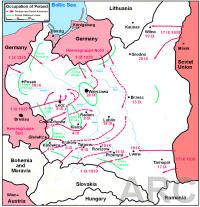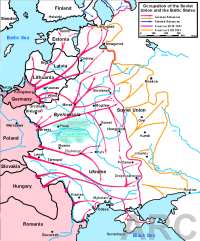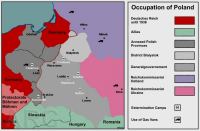 |
| Hitler and Himmler |
On
1 September 1939 a
Wehrmacht force of 1.25 million men swept into Poland
in the wake of heavy aerial bombardments. After two weeks the Polish capital
Warsaw was captured.
On
17 September the Soviet Union invaded the eastern part of the country.
Following the surrender of Polish forces on
28 September, Germany and the
USSR agreed to divide Poland between them in accordance with the secret protocol of the
Ribbentrop-Molotov pact
(
see the map). Poland ceased to exist as a sovereign State.
The western and northern regions of Poland were annexed to the
Reich; the southern and eastern
regions were given the status of a colony, named the
Generalgouvernement (ruled by
Hans Frank with the capital established in
Krakow. More than 2 million Jews lived in the German occupied
territory, with about 1.2 million Jews in the eastern areas occupied by the USSR.
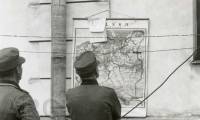 |
| Orientation |
The annexed parts were controlled by a German administration ruled
by a
Gauleiter, a system similar in practice to that of the
Reich
itself. Nearly 1 million Poles were expelled from this German ruled
area, while 600,000 Germans from eastern Europe and 400,000 from the
German
Reich were settled there. After the Germans attacked
the Soviet Union in
June 1941, the rest of Poland also succumbed to
German rule. The southeastern region, occupied by the Soviets in
1939
(
Distrikt Galizien), became part of the
Generalgouvernement.
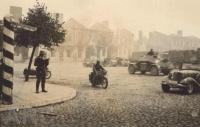 |
| Occupation Forces in 1939 |
The aim of the German occupation policy was to utilise Poland as a German living space,
to exploit the material resources of the country and to maximise the use of Polish
manpower as a reservoir of virtual or actual slave labour. The Polish nation was to
be effectively reduced to the status of helotry, its political, religious and intellectual
leadership destroyed. The agents targeted with accomplishing this policy were the SS,
Polizei,
and
Wehrmacht. In an action codenamed "Operation Tannenberg" ("
Unternehmen Tannenberg") in
September and October 1939, an estimated 760 mass
executions were carried out by
Einsatzkommandos, resulting in the deaths
 |
| Lapanka |
of at least 20,000 of the most prominent Polish citizens. Expulsion and murder
became commonplace. People were rounded up in the streets during so-called
lapankas
and sent to either forced labour in Germany or to
Auschwitz. Some were held hostage
in the
Pawiak Prison in
Warsaw and later executed. Sometimes
people rounded up were executed on the spot by firing squads. Millions of Poles were
press-ganged for compulsory labour, both within Poland and in the
Reich.
Polish identity cards were replaced by the "
Kennkarte" (identifying card).
Those who applied for it had to fill out an
affidavit that they were no Jews. Ultimately,
the Nazi's "New Order" in Poland would result in the death of 20% of the population,
some 6 million people, half of them Jewish.
During the occupation many Poles fought in a variety of different resistance movements
organised within Poland along political lines. Expatriate Poles also served as soldiers
in a number of countries as members of the Allied Forces.
The Polish Jews had no chance of escaping. As early as
September 1939,
Reinhard Heydrich, chief of the
Sipo (
Sicherheitspolizei /
security police),
SD (
Sicherheitsdienst der SS / security agency of the SS) and later
RSHA
(
Reichssicherheitshauptamt), had given orders to concentrate
the Jews in larger towns located near railway lines. In
November 1939
Hans Frank issued an order for the establishment of a
Judenrat in
each municipality, and commanded the Jews to wear an
armband. The
Judenrat became the link between the
Jewish population and the Nazis. It was forced to deliver lists of
inhabitants, to install a Jewish police force and to manage the work,
accommodation and public health services of its municipality. Before
the attack on the Soviet Union took place, the Jews had already become
forced labour convicts and lost their jobs. They were ordered to declare
their valuables and their houses – factories, shops, and personal property of all kinds
were confiscated. From the smallest shtetl to the largest city, normal public Jewish
life ceased to exist. By
early 1941 about 200 forced labour camps for
Jews had been established.
The death toll in these camps was extremely high because of the prevailing inhuman
conditions and the harsh regime.
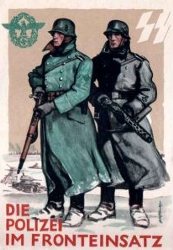 |
| Police Postcard |
The Nazis tried to concentrate all Jews in
Ghettos in order to facilitate the
Endlösung der Judenfrage (Final Solution of the Jewish Question),
although what that "solution" was going to be was initially unclear. The process of establishing
ghettos for the Jews started in
October 1939. The death toll in the ghettos
was high, caused by
factors such as the desperate (and deliberate) shortage of food and the lack of adequate sanitation
and hygiene, resulting in famine and epidemics.
With the onset of the attack on the Soviet Union the full-scale extermination
of Jews began. In co-operation with the
Wehrmacht, SS, SD and
Sipo, four
Einsatzgruppen (task forces) were
established. These killing units followed the German troops on
their way eastward. They were ordered to eliminate communist
officials, partisans and Jews.
Between June 1941 and the spring of 1943, the
Einsatzgruppen killed approximately 1.2 million Jews and
some hundreds of thousands of Soviet citizens. Generally victims were
shot at secluded sites, and their corpses hurriedly buried. Many of
the killers suffered physical and psychological stress as a consequence of
shooting innocent, naked, men, women, and children. As a result
Heinrich Himmler ordered the
RSHA
to find another killing method. This ultimately led to the design of
specially converted enclosed lorries, the exhaust fumes of which were diverted to gas
the victims in an airtight passenger area. 15 of these
gas vans were delivered to the
Einsatzgruppen. They were also used in
Chelmno as early as
December 1941.
Here, 250,000 to 300,000 Jews from the
Warthegau and the
Lodz Ghetto perished, among them
approximately 10,000 Jews who had been
deported from Germany, Austria and Czechoslovakia.
In order to accelerate the elimination of the Polish Jews, five
extermination camps with stationary gas chambers were built:
Auschwitz-Birkenau
in the annexed region of Eastern Upper Silesia, and
Belzec,
Sobibor,
Treblinka and
Majdanek in the
Generalgouvernement.
Hundreds of
trains, operated by the
German
Reichsbahn or
Gedob (Generaldirektion der Ostbahn), carried the Jews to these killing facilities.
Transports were often diverted to
transit ghettos, where Jews
were temporarily incarcerated until the death camps were ready to receive them.
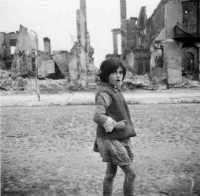 |
| Jewish Girl in Zwolen 1939 |
All of those transported to
Belzec, Sobibor, Treblinka and
Chelmno were
destined for death within a few hours. At
Auschwitz-Birkenau and
Majdanek
the deportees were either selected for immediate death in the gas chambers
or chosen for forced labour. In time the same result ensued. Many
barracks were built at
Auschwitz-Birkenau and
Majdanek to house the forced labourers.
The permanent gassing installations (gas chambers) were logical successors to the mobile gas vans.
German factory owners, and even the
Wehrmacht, profited from
the forced Jewish labour resource. Because of manpower shortages,
Hitler agreed that Jewish workers would remain within the
Generalgouvernement domain for a certain time, subject to the
condition that they work only in factories and camps controlled by the SS.
In line with this ruling, special labour camps were established: for
example at
Poniatowa
and
Trawniki
near
Lublin,
Plaszow
near
Krakow and
Janowska near
Lwow. At the extermination camps
Majdanek
near
Lublin
and
Auschwitz near
Krakow, the newly arrived
victims were divided
into groups either fit or unfit for work. Those unfit
for work, were taken immediately to the gas chambers. Those
considered fit, were crowded together under unimaginably bad
conditions and systematically killed by hard work and the permanent
lack of food, or were simply murdered by SS-men. As their strength ebbed and their
capacity for work diminished, the prisoners were subject to constant further selections
and consequent execution.
Two resistance uprisings took place in
Warsaw: the Jewish
Warsaw Ghetto Uprising from 19 April
until 16 May 1943, and the Polish
uprising organized by the underground army Armia Krajowa,
which took place
from 1 August until 2 October 1944: The Poles
revolted in
Warsaw as the Soviet forces were nearby. Receiving only
minimal help from the Allied Forces, the Polish resistance had no
real chance of defying the heavily armed German troops. After the
defeat of the Armia Krajowa,
Hitler gave orders for the
destruction of
Warsaw. The population had to leave the city. German
troops entered
Warsaw where they remained until
December 1944,
destroying the city and looting many art treasures. More than 200,000 Poles died in the course
of the
1944 uprising and an estimated 700,000 were expelled from the city.
The last of the German occupying forces left Poland in
early 1945. No
other nation suffered as much at the hands of the Nazis as did Poland.
The defeat of the Nazis did not bring the longed for freedom,
as the Soviets remained in control of the country until the
1980ies.
See our pages about
Zwolen, an ordinary town in the
Generalgouvernement,
located between
Radom and
Pulawy.
The history of this town is symbolic of all other Polish towns, showing that the Nazi terror happened everywhere.
© ARC 2005












